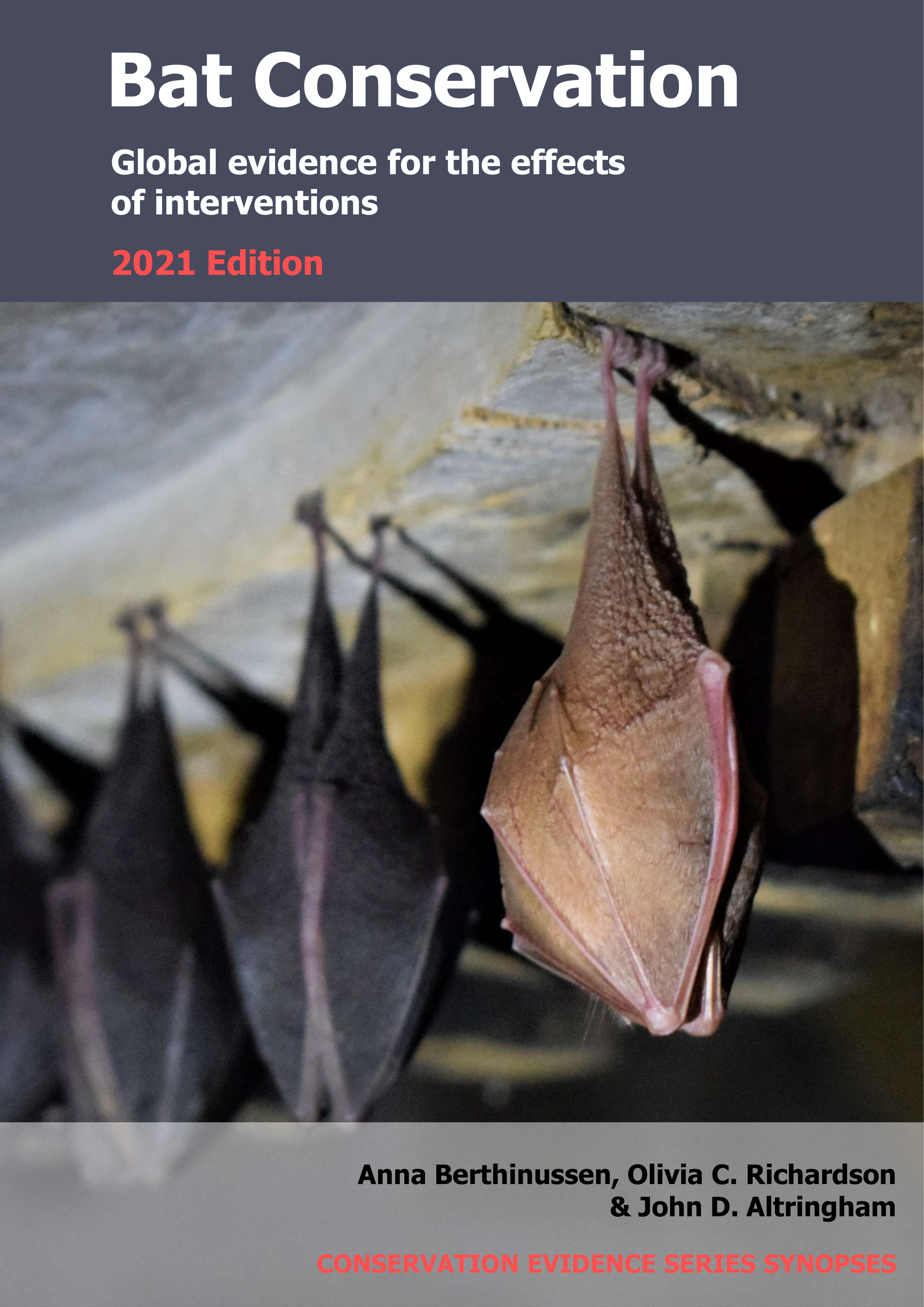Actions to conserve biodiversity
We have summarised evidence from the scientific literature about the effects of actions to conserve wildlife and ecosystems.
Review the evidence from the studies
Not sure what Actions are? Read a brief description.
Search for evidence
e.g. "frogs chytrid"
200 Actions found
Refine
Hide
200 Actions found
Download Actions
| 0 selected |
|
Order results by:
| Action | Effectiveness | Studies | Category | |
|---|---|---|---|---|
|
Reduce field size (or maintain small fields) Action Link |
Unknown effectiveness (limited evidence) | 1 |
|
|
|
Retain unmown field margins Action Link |
Unknown effectiveness (limited evidence) | 1 |
|
|
|
Plant field margins with a diverse mix of plant species Action Link |
Unknown effectiveness (limited evidence) | 1 |
|
|
|
Plant new hedges Action Link |
No evidence found (no assessment) | 0 |
|
|
|
Manage hedges to benefit bats Action Link |
Unknown effectiveness (limited evidence) | 2 |
|
|
|
Manage ditches to benefit bats Action Link |
No evidence found (no assessment) | 0 |
|
|
|
Retain existing in-field trees Action Link |
No evidence found (no assessment) | 0 |
|
|
|
Plant in-field trees Action Link |
No evidence found (no assessment) | 0 |
|
|
|
Retain remnant forest or woodland on agricultural land Action Link |
No evidence found (no assessment) | 0 |
|
|
|
Avoid the use of antiparasitic drugs for livestock Action Link |
No evidence found (no assessment) | 0 |
|
|
|
Manage grazing regimes to increase invertebrate prey Action Link |
No evidence found (no assessment) | 0 |
|
|
|
Replace culling of bats with non-lethal methods of preventing vampire bats from spreading rabies to livestock Action Link |
No evidence found (no assessment) | 0 |
|
|
|
Manage livestock water troughs as a drinking resource for bats Action Link |
Likely to be beneficial | 2 |
|
|
|
Prevent culling of bats around fruit orchards Action Link |
No evidence found (no assessment) | 0 |
|
|
|
Use non-lethal measures to prevent bats from accessing fruit in orchards to reduce human-wildlife conflict Action Link |
Likely to be beneficial | 2 |
|
|
|
Introduce certification for bat-friendly crop harvesting regimes Action Link |
No evidence found (no assessment) | 0 |
|
|
|
Apply textured coating to turbines Action Link |
Unknown effectiveness (limited evidence) | 1 |
|
|
|
Deter bats from turbines using low-level ultraviolet light Action Link |
No evidence found (no assessment) | 0 |
|
|
|
Paint turbines to reduce insect attraction Action Link |
No evidence found (no assessment) | 0 |
|
|
|
Increase the wind speed at which turbines become operational (‘cut-in speed’) Action Link |
Beneficial | 12 |
|
|
|
Exclude bats from roosts prior to mine reclamation Action Link |
No evidence found (no assessment) | 0 |
|
|
|
Retain access points for bats following mine closures Action Link |
No evidence found (no assessment) | 0 |
|
|
|
Install and maintain gates at mine entrances to restrict public access Action Link |
Trade-off between benefit and harms | 9 |
|
|
|
Maintain microclimate in closed/abandoned mines Action Link |
Unknown effectiveness (limited evidence) | 1 |
|
|
|
Reopen entrances to closed mines and make suitable for roosting bats Action Link |
No evidence found (no assessment) | 0 |
|
Download Actions
| 0 selected |
|

Bat Conservation - Published 2021
Update 2020
Watch this search
If you are familiar with RSS feeds, please click the button below to retrieve the feed URL:
RSS feed for this searchIf you are unfamiliar with RSS feeds, we would suggest reading this BBC article.
Unfortunately, due to the number of feeds we have available, we cannot provide e-mail updates. However, you could use tools such as Feed My Inbox to do this for you.
What are 'Individual studies' and 'Actions'?
Individual studies
An individual study is a summary of a specific scientific study, usually taken from a scientific journal, but also from other resources such as reports. It tells you the background context, the action(s) taken and their consequences.
If you want more detail please look at the original reference.
Actions
Each action page focuses on a particular action you could take to benefit wildlife or ecosystems.
It contains brief (150-200 word) descriptions of relevant studies (context, action(s) taken and their consequences) and one or more key messages.
Key messages show the extent and main conclusions of the available evidence. Using links within key messages, you can look at the paragraphs describing each study to get more detail. Each paragraph allows you to assess the quality of the evidence and how relevant it is to your situation.
Where we found no evidence, we have been unable to assess whether or not an intervention is effective or has any harmful impacts.





)_2023.JPG)














